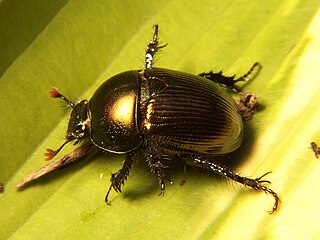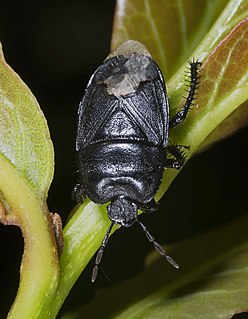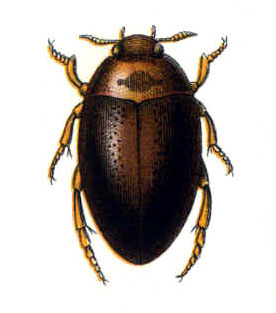
The Fanti saw-wing, also known as the Fanti rough-winged swallow, is a small passerine bird in the swallow family.

Megalon is a kaiju who first appeared in Toho's 1973 film Godzilla vs. Megalon.

The eastern mole or common mole is a medium-sized, overall grey North American mole and the only member of the genus Scalopus. Its large, hairless, spade-shaped forefeet are adapted for digging. The species is native to Canada (Ontario), Mexico, and the eastern United States, and has the widest range of any North American mole.

Geotrupidae is a family of beetles in the order Coleoptera. They are commonly called earth-boring dung beetles. Most excavate burrows in which to lay their eggs. They are typically detritivores, provisioning their nests with leaf litter, but are occasionally coprophagous, similar to dung beetles. The eggs are laid in or upon the provision mass and buried, and the developing larvae feed upon the provisions. The burrows of some species can exceed 2 metres in depth.

Cydnidae are a family of shield bugs, known by common names including burrowing bugs or burrower bugs. In some older classifications, Cydnidae, sensu lato includes the subfamily Thyreocorinae, which are known commonly as negro bugs, or ebony bugs, and/or the families Thaumastellidae and Parastrachiidae. Though similar in appearance to a beetle at casual glance, they can be distinguished by both their piercing/sucking mouthparts, and wing configuration. Of some 750 species of burrower bugs, 27 are reported as crop pests, and six species are thought to feed on peanut.
Suphisellus anticicollis is a species of burrowing water beetle in the subfamily Noterinae. It was described by Félix Guignot in 1950 and is found in Ecuador.
Suphisellus hieroglyphicus is a species of burrowing water beetle in the subfamily Noterinae. It was described by Zimmermann in 1921 and is found in Brazil.
Suphisellus pereirai is a species of burrowing water beetle in the subfamily Noterinae. It was described by Félix Guignot in 1958 and is found in Brazil.
Suphisellus variicollis is a species of burrowing water beetle in the subfamily Noterinae. It was described by Zimmermann in 1921 and is found in Argentina, Bolivia and Brazil.
Suphisellus bruchi is a species of burrowing water beetle in the subfamily Noterinae. It was described by Zimmermann in 1919 and is found in Argentina and Brazil.
Suphisellus dilutus is a species of burrowing water beetle in the subfamily Noterinae. It was described by Sharp in 1882 and is found in Brazil.
Suphisellus globosus is a species of burrowing water beetle in the subfamily Noterinae. It was described by Régimbart in 1903 and is found in Brazil.
Suphisellus grossus is a species of burrowing water beetle in the subfamily Noterinae. It was described by Sharp in 1882 and is found in Argentina, Brazil and Paraguay.
Suphisellus majusculus is a species of burrowing water beetle in the subfamily Noterinae. It was described by Sharp in 1882 and is found in Colombia, Panama and Venezuela.
Suphisellus ovatus is a species of burrowing water beetle in the subfamily Noterinae. It was described by Sharp in 1882 and is found in Argentina and Brazil.
Suphisellus sexnotatus is a species of burrowing water beetle in the subfamily Noterinae. It was described by Régimbart in 1889 and is found in Brazil.
Suphisellus subsignatus is a species of burrowing water beetle in the subfamily Noterinae. It was described by Sharp in 1882 and is found in Colombia and Panama.
Suphisellus tenuicornis is a species of burrowing water beetle in the subfamily Noterinae. It was described by Chevrolat in 1863 and is found in Cuba.
Suphisellus rufulus is a species of burrowing water beetle in the subfamily Noterinae. It was described by Zimmermann in 1921 and is found in Bolivia and Brazil.





